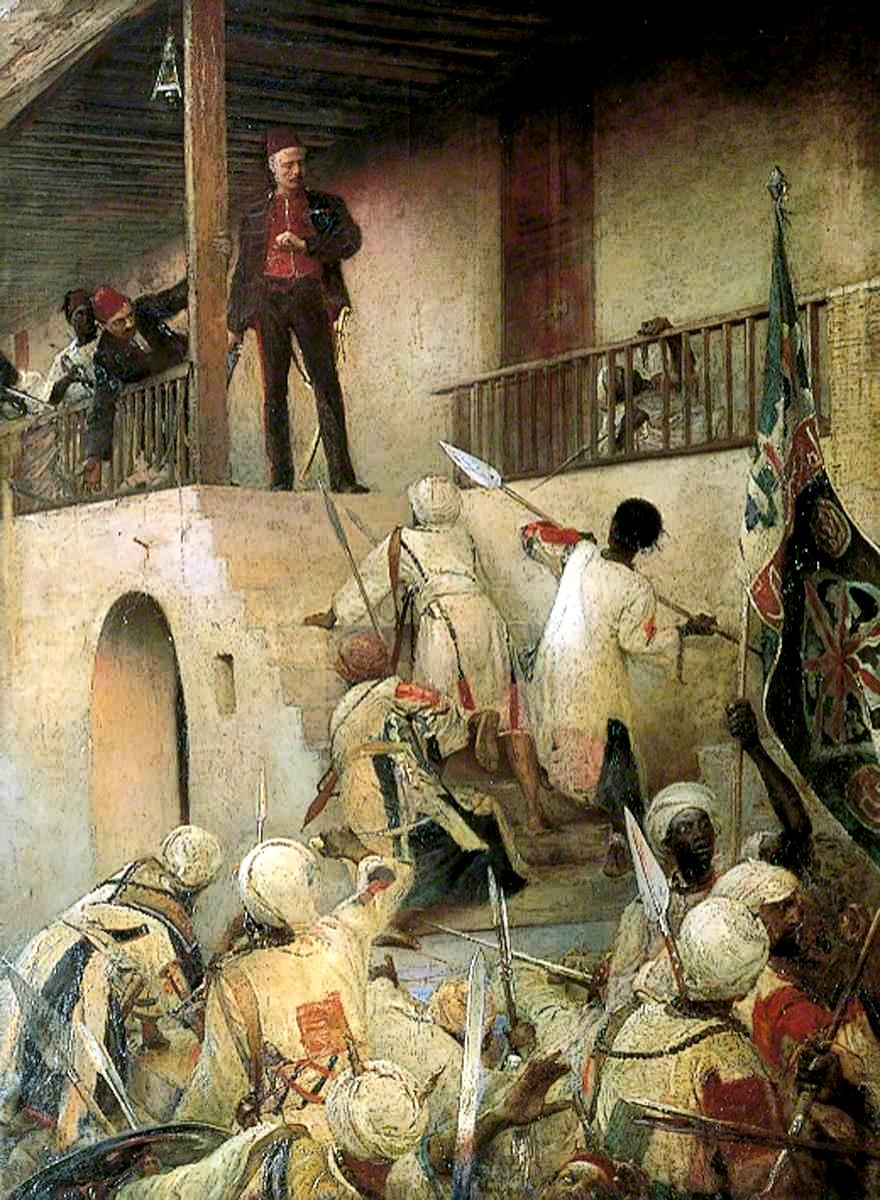
Gordon of Khartoum (England, 1833-85)

Figure 1.--This dramatic painting by George William Joy is an imaginative depiction of Gordon's last stand. This helped burnish Gorson's already heroic image in Victorian England. He mafe his name first in China and then for efforts to end the slave trade in Egypt and Sudan.
|
|
Major General Charles George Gordon was an army officer who became a major figure of the Victoria era, associated with the British Empire. He became known variouly as Chinese Gordon, Gordon Pasha, and Gordon of Khartoum. He first saw action in the Crimean War as a junior officer. He became famous because of his service in China. He was gicen command of the "Ever Victorious Army" a force of Chinese soldiers led by European officers (early-1860s). Gordon's commnd played a role in putting down the widespread Taiping Rebellion. They commoly faced much larger forces. As aresult he became a hero of Victorian Britain ad known as "Chinese" Gordon. He was awarded honors from both the Emperor of China and the British Army. He next entered the service of the Egyptian Khedive (1873). The British government concerned with the Suez Canal approved. The Brutisg wre also cincerned with suppresing the African slave trade and Gordon's effot added to his reputation in Britain, but not in Aran world where slavery had Koranic justification. Gordon was appointed Governor-General of the Sudan, part of a British-Egyptian condeminium. The slave trade was even more pronounced in the Sudan. The work was hllnging and an exhausted Gordon resigned (1880). Sudanese support for the slave trade was strong. And British efforts to suppres it stirred up resistance. As a result, after Gordon left, a revolt then broke out in the Sudan, led by a Muslim religious leader and self-proclaimed Mahdi, Muhammad Ahmad. It grew into a major revolt which threaened the British-Egyptian presence in Sudan. At the time Prime Minister Gladstone who had opposed the expansion if the British Empire on moral grounds wnted no part of a colonial war. The Brutish public, however, demanded action. Finally he authorized sending Gordon back to Khartoum, but with instructions to secure the evacuation of Britsh subjects and loyal Egyptians and Sudaese soldiers and civilians and to leave with them. He began by evacuating about 2,500 British civilians, but in defiance to those instructions, he decided to make a stand in the city, thinking this would force the Prime Minister's hand and force him to send a relief force. Grdon retained a small group of soldiers and non-military men and preared for battle. The two adversaries corresponded, each attempting to convert the other to his faith, but of course neither agreed. Despite the massive forces the Mahdi mustered around besieged Khartoum, Gordon managed to organized a defence which held out nearly a year. Gordon had calculated correctly. He became emensly popular in Britain and the public demand to save him finlly forced the Government to reluctanly send a relief force. It arrived 2 days after the Mahdi had taken the city and killed Gordon. Joy painted a heroic image of the end, although the exact circumstances are unknow. It emhaszes the heoic idea of a lone English manding up for God, king, and country and efforts to end the slave trade. Joy painted his work soon after Gordon was killed as a paen to the British Empire. The British left after finding Gordon dead. The British did not return until 1896 and a small force with modrn weapond destroyed the huge Mahdist army. The force was commanded by Lord Kitchener and included a Lieutenant Winston Churchill who prticipated in some of the last cavalry carges in British militry history.
CIH

Navigate the Boys' Historical Clothing Artists pages:
[Return to Main George William Joy career page]
[Return to Main George William Joy page]
[Return to Main Artists G-L page]
[Return to Main Irish artist page]
[Return to Main Art page]
[Chronology]
[Countries]
[Individuals]
[Styles]
Navigate the Children in History Website:
[About Us]
[Introduction]
[Biographies]
[Chronology]
[Climatology]
[Clothing]
[Disease and Health]
[Economics]
[Freedom]
[Geography]
[History]
[Human Nature]
[Ideology]
[Law]
[Nationalism]
[Presidents]
[Religion]
[Royalty]
[Science]
[Social Class]
[Bibliographies]
[Contributions]
[FAQs]
[Glossaries]
[Images]
[Links]
[Registration]
[Tools]
[Children in History Home]
Created: 10:04 PM 7/28/2016
Last updated: 10:04 PM 7/28/2016



